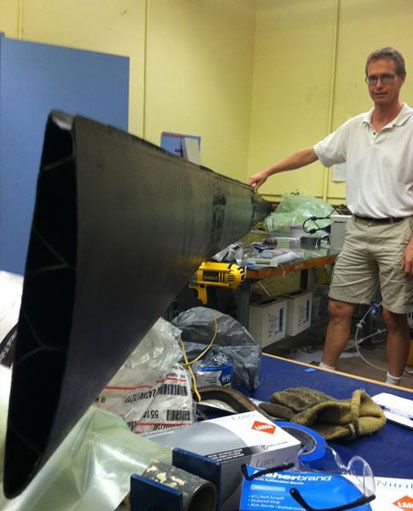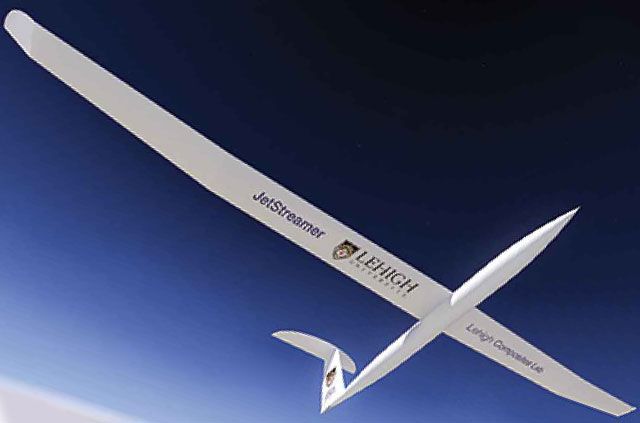
Lehigh engineers team up with RC legend Spencer Lisenby to break dynamic soaring flight record
A craft that achieves perpetual unmanned flight—one that mimics a seabird to power its travels—is set for preliminary testing next month in the skies above central California, and it just may break a world record in the process.
The so-called "Lehigh JetStreamer" is the result of a partnership between Lehigh mechanical engineering professor Joachim Grenestedt, computer science and engineering professor John Spletzer, and a team of students in their lab over the last five years.
Grenestedt is an expert in designing, manufacturing and operating advanced vehicles, often using engineered composite materials in his quest for the lightest yet sturdiest of vehicles for land, sea, and air, and even snow. Spletzer has been on the forefront in developing autonomous vehicles, including the success of the Penn-Lehigh "Little Ben" vehicle in 2008's DARPA Urban Challenge, and an autonomous wheelchair system that can navigate city sidewalks and streets on behalf of its user.
The JetStreamer's maiden voyage is scheduled for January 6, 2016, outside of Weldon, California, with renowned RC pilot Spencer Lisenby at the controls. If successful, the team will set the record for the largest dynamically soaring unmanned (remote control, or RC) aircraft. The Lehigh-designed craft has a wing span of six meters, one meter longer than the current record holder.
Endless, effortless flight
The inspiration for the team's unmanned aerial vehicle, or UAV, comes from the flight of the albatross. Gliding just above the surface of the ocean, wings locked, the albatross angles gently upward into faster-moving winds to reach higher altitudes, and then coasts downward again to gain speed. This repetitive cycle, called dynamic soaring or DS, enables the bird to draw energy by exploiting the wind gradient, or difference in wind velocities between adjacent streams of moving air.
According to Grenestedt, dynamic soaring is a particular flight process in which the aircraft is propelled by horizontal winds. "It is markedly different from other types of soaring such as ridge or orographic soaring, thermal soaring, or wave soaring where the aircraft is propelled by vertical winds or rising air."
"The albatross can fly a thousand kilometers a day while expending almost no energy," says Spletzer. "We need to emulate that."
Once the craft is launched into the jet stream, which has layers of air moving at different speeds, it will exploit these gradients to extract energy and sustain flight. In terms of its application, they sky's the limit. One of the most interesting applications is meterological -- flying it directly into the fury of a hurricane to gather an incredible, sustained data set that's not currently available to the National Hurricane Center within NOAA or other government and private agencies concerned with weather prediction and analysis. More generally, the craft could serve as what Grenestedt calls a "poor man's satellite," or for low-cost aerial tasks.
Putting it all together
Grenestedt, assisted by graduate student Jake Patterson '12 and Ph.D. candidate Robert Thodal, has constructed the JetStreamer out of layers of a carbon fiber composite pre-impregnated with an epoxy binder.
Finding the right construction technique was a laborious process of trial and error, as attested by the dozens of experimental wing sections that littered Grenestedt's lab over the course of the project. Every imperfection can sap precious energy from a DS craft. The plane must endure 300 mph speeds, altitudes up to 60,000 feet and 20g of load on its 50-kg frame—about one ton's worth of force distributed across a plane with a skin only 1/40th of an inch thick in some places. Yet if the UAV can tolerate the high speeds and forces incurred by sharply banked turns and maneuvers, it will increase its odds of following the most energy-efficient flight path.
The increase in wingspan on the JetStreamer, according to Grenestedt, is akin to greater engine displacement for a dragster. "Longer wings provide higher performance," he says, "but they are more complex to build." He notes that the craft's asymmetric wingspan accounts for future plans to outfit the vehicle with a jet engine; to avoid hot jet blasts hitting the fin, the fuselage is shifted slightly and the engine will be mounted in counterbalance.
On the command and control side, Spletzer has worked with Corey Montella, a Lehigh Ph.D. student in computer engineering who is entrusted with writing the code for the on-board computer. They have validated their software design and planning algorithms using a modified hobby aircraft outfitted with an off-the-shelf automatic pilot device and an embedded computer that makes real-time decisions on flight paths.
"These are big challenges," Spletzer says. "We need to do things fast, like update wind field and trajectory data as many as 40 times per second. It's also tough to verify the ground truth—the actual facts regarding local conditions. So the system has to be robust."




